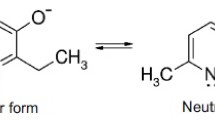Summary
In experiments on male Wistar rats it has been found that nifedipine administration at a dose of 10 mg/kg body weight i.p. daily for 20 days did not significantly increase the total amount of cytochrome P-450 but markedly increased the 7α-, 16β- and 6β-hydroxylation of androstendione in liver microsomes, suggesting the induction of cytochromes P-450HA1, P-450UB1, and P-450IQA1, respectively. The induction of cytochrome P-450IHB1 was also confirmed immunochemically with polyclonal antibodies against cytochrome P-450HB1/B2.
Similar content being viewed by others
Abbreviations
- AD:
-
androstendione
- HPLC:
-
high performance liquid chromatography
References
Neben D.W., Nelson D.J.R., Adesnik M., et al. (1989): The P-450 superfamily: Updated listing of all genes and recommended nomenclature for the chromosomal loci. DNA, 8, 1–13.
Burke M.D., Mayer R.T. (1983): Differential effects of phenobarbitone and 3-methylcholanthrene induction of the hepatic microsomal metabolism and cytochrome P-450 binding of phenoxazone and a homologous series of its normal-alkyl ethers (alkoxyresorufins). Chem. Biol. Interact, 45, 243–258.
Kamataki T., Maeda K., Yamazoe Y., Matsuda N., Ishii K., Kato A. (1983): A high-spin form of cytochrome P-450 highly purified from polychlorinated biphenyl-treated rats. Catalytic characterization and immunochemical quantitation in liver microsomes. Mol. Pharmacol., 24, 146–155.
Wood A.W., Ryan D.E., Thomas P.E., Levin W. (1983): Regio- and stereoselective metabolism of two C19-steroids by five highly purified and reconstituted rat hepatic cytochrome P-450 isozymes. J. Biol. Chem., 258, 8839–8847.
Waxman D.J. (1984): Rat hepatic cytochrome P-450 isozyme 2c. Indication as male-specific, developmentaUy induced steroid 16-alpha-hydroxylase and comparison to a female-specific cytochrome P-450 isozyme. J. Biol. Chem., 259, 5481–5490.
Sonderfan A.J., Arlotte M.P., Dutton D.R., McMillen S.K., Parkinson (1987): Regulation of testosterone hydroxylation by rat liver microsomal cytochrome P4S0. Arch. Biochem. Biophys., 255, 27–41.
Guengerich F.P., Martin M.V., Beaune P.H., Kremers P., Wolff T., Waxman D.J. (1986): Characterization of rat and human liver microsomal cytochrome P-450 form involved in nifedipine oxidation, a prototype for genetic polymorphism in oxidative drug metabolism. J. Biol. Chem., 261, 5051–5060.
Heuman D.M., Gallagher E.J., Barwick J.L., Elshourbagy N.A., Guzelian P.S. (1982): Immunochemical evidence for induction of a common form of hepatic cytochrome P-450 in rats treated with pregnenolone-16-alpha carbonitrile or other steroidal or non-steroidal agents. Mol. Pharmacol., 21, 753–760.
Schuetz E.G., Wrighton S.A., Barwick J.L., Guzelian P.S. (1984): Induction of cytochrome P-450 by glucocorticoids in rat liver. 1. Evidence that glucocorticoids and pregnenolone 16-alpha-carbonitrile regulate de novo synthesis of a common form of cytochrome P-450 in culture of adult rat hepatocytes and in the liver in vivo. J. Biol. Chem., 259, 1999–2006.
Watkins P.B., Maurel P., Schuets E.G., Wrighton S.A., Parker G., Guzelian P.S. (1985): Identification of human cytochrome P-450 isozymes inducible by glucocorticoids and macrolide antibiotics. Fed. Proc., 44, 1206–1210.
Elshourbagy N.A., Guzelian P.S. (1980): Separation, purification and characterization of a novel form of cytochrome P-450 from rats treated with pregnenolone-16α-carbonitrile. J. Biol. Chem., 255, 1279–1284.
Koleva M. Stoytchev Ts. (1988): Effect of nifedipine on the rat liver monooxygenases. CR Acad. Bulg. Sci., 41, 147–150.
Omura T., Sato R. (1964): The carbon monoxide-binding pigment of liver microsomes. Solubilization, purification and properties. J. Biol. Chem., 239, 2379–2385.
Phillips A.H., Langdon R.G. (1962): Hepatic triphosphopyridine nucleotide-cytochrome c reductase: isolation, characterization and kinetic studies. J. Biol. Chem., 237, 2652–2660.
Lowry O.H., Rosebrough N.J., Fair A.L. Randall R.J. (1952): Protein measurement with phenol reagent. J. Biol. Chem., 193, 265–275.
Nash T. (1953): The calorimetric estimation of formaldehyde by means of Hantzsch reaction. Biochem. J., 55, 416–421.
Lyakhovich V.V., Tsyrlov I.B., Gromova O.A., Rivkind N.V. (1979): Activities of 3,4, benzpyrene hydroxylase systems reconstituted by means of self-assembly from control and 3-methylcholanthrene inducible liver microsomes of “susceptible” and “unsusceptible” mice. Biochem. Biophys. Res. Commun., 81, 1329–1334.
Guengerich F.P., Martin M.V. (1980): Purification of cytochrome P-450, NADPH-cytochrome P-450 reductase and epoxide hydrolase from a single preparation of rat liver microsomes. Arch. Biochem. Biophys., 205, 365–379.
Kamataki T., Belcher D.H., Neal R.A. (1976): Studies of the metabolism of parathion and benzphetamine using an apparently homogenous preparation of rat liver cytochrome P-450: effect of a cytochrome P-450 antibody preparation. Mol. Pharmacol., 12, 921–932.
Pickett C.B., Jeter R.L., Morin J., Lu A.Y.H. (1981): Electroimmunochemical quantitation of the cytochrome P-450, cytochrome P-448 and epoxide hydrolase in rat liver microsomes. J. Biol. Chem., 256, 8815–8820.
Gutkina N.I, Mishin V.M. (1986): Immunochemical evidence that hexachlorobenzene induced two form of cytochrome P-450 in the rat liver microsomes. Chem. Biol. Interact., 58, 57–68.
Dannan G.A, Guengerich F.P., Kaminsky L.S, Aust S.D. (1982): Regulation of cytochrome P-450. Immunochemical quantitation of eight isozymes in liver microsomes of rats treated with polybrominated biphenyl congeners. J. Biol. Chem., 258, 1282–1288.
Author information
Authors and Affiliations
Additional information
TheNomenclature System of Nebert et al. (1) is used throughout this paper to designate cytochrome P-450 forms.
Rights and permissions
About this article
Cite this article
Koleva, M., Stoytchev, T., Gulyaeva, L. et al. Induction of cytochrome P-450 isozymes upon repeated administration of nifedipine. European Journal of Drug Metabolism and Pharmacokinetics 16, 103–106 (1991). https://doi.org/10.1007/BF03189945
Received:
Issue Date:
DOI: https://doi.org/10.1007/BF03189945



